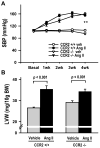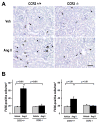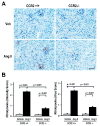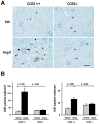Role of inflammation in the development of renal damage and dysfunction in angiotensin II-induced hypertension
- PMID: 18541733
- PMCID: PMC2562771
- DOI: 10.1161/HYPERTENSIONAHA.108.112706
Role of inflammation in the development of renal damage and dysfunction in angiotensin II-induced hypertension
Abstract
Angiotensin II (Ang II)-induced hypertension is associated with an inflammatory response that may contribute to the development of target organ damage. We tested the hypothesis that, in Ang II-induced hypertension, CC chemokine receptor 2 (CCR2) activation plays an important role in the development of renal fibrosis, damage, and dysfunction by causing oxidative stress, macrophage infiltration, and cell proliferation. To test this hypothesis, we used CCR2 knockout mice (CCR2-/-). The natural ligand of CCR2 is monocyte chemoattractant protein-1, a chemokine important for macrophage recruitment and activation. CCR2-/- and age-matched wild-type (CCR2+/+) C57BL/6J mice were infused continuously with either Ang II (5.2 ng/10 g per minute) or vehicle via osmotic minipumps for 2 or 4 weeks. Ang II infusion caused similar increases in systolic blood pressure and left ventricular hypertrophy in both strains of mice. However, in CCR2-/- mice with Ang II-induced hypertension, oxidative stress, macrophage infiltration, albuminuria, and renal damage were significantly decreased, and glomerular filtration rate was significantly higher than in CCR2+/+ mice. We concluded that, in Ang II-induced hypertension, CCR2 activation plays an important role in the development of hypertensive nephropathy via increased oxidative stress and inflammation.
Figures








Comment in
-
The flame that lights the fire: oxidative stress, inflammation, and renal damage in angiotensin II-induced hypertension.Hypertension. 2008 Aug;52(2):205-6. doi: 10.1161/HYPERTENSIONAHA.108.115402. Epub 2008 Jun 9. Hypertension. 2008. PMID: 18541731 No abstract available.
-
Inflammation, angiotensin II, and hypertension.Hypertension. 2008 Nov;52(5):e135; author reply e136. doi: 10.1161/HYPERTENSIONAHA.108.121145. Epub 2008 Oct 6. Hypertension. 2008. PMID: 18838621 Free PMC article. No abstract available.
References
-
- Ruiz-Ortega M, Esteban V, Ruperez M, Sanchez-Lopez E, Rodriguez-Vita J, Carvajal G, Egido J. Renal and vascular hypertension-induced inflammation: role of angiotensin II. Curr Opin Nephrol Hypertens. 2006;15:159–166. - PubMed
-
- Li JJ, Fang CH, Hui RT. Is hypertension an inflammatory disease? Med Hypotheses. 2005;64:236–240. - PubMed
-
- Mehta PK, Griendling KK. Angiotensin II cell signaling: physiological and pathological effects in the cardiovascular system. Am J Physiol Cell Physiol. 2007;292:C82–C97. - PubMed
-
- Boring L, Gosling J, Cleary M, Charo IF. Decreased lesion formation in CCR2−/− mice reveals a role for chemokines in the initiation of atherosclerosis [letter] Nature. 1998;394:894–897. - PubMed
Publication types
MeSH terms
Substances
Grants and funding
LinkOut - more resources
Full Text Sources
Medical
Research Materials
Miscellaneous

